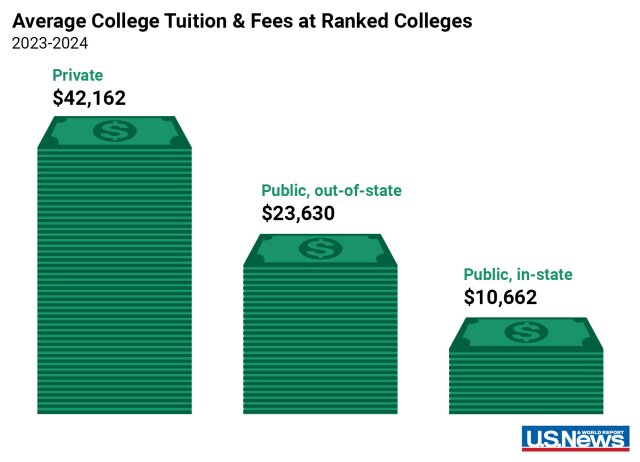The average college tuition cost has increased in the 2023-2024 academic year over the prior year across both public and private schools, according to U.S. News data based on an annual survey.
A college’s sticker price is the amount advertised as the full rate for tuition and fees before financial need, scholarships and other aid are factored in. Net price is the amount that a family pays after aid and scholarships – usually offsetting the sticker price shock.
The average tuition and fees at private ranked colleges has climbed by about 4% over the last year, according to data for the 2023-2024 school year submitted to U.S. News in an annual survey. At ranked public schools, tuition and fees rose 2% for in-state students and about 1.4% for out-of-staters.
Considering inflation, the year-over-year numbers look a little different. For private ranked colleges, tuition and fees actually decreased by 0.4%. For public ranked schools, there was also a decline: about 2% for in-state students and about 3% for out-of-state students.
Schools reported this data in spring and summer of 2023. Some colleges offer tuition discounts to eligible students: 341 private nonprofit colleges and universities reported an average estimated tuition discount rate of 56.2% for full-time, first-year, first-time students in 2022-2023, according to a study from the National Association of College and University Business Officers.
But the cost of education remains a significant financial challenge for many families, who often underestimate the price.
According to the 2023 Fidelity Investments survey College Savings & Student Debt, 1 in 4 high school students believe the total cost of attendance for one year of college equals $5,000 or less. This number is far below what they’re likely to pay at public and private four-year colleges.
The average in-state cost of tuition and fees to attend a ranked public college is nearly 75% less than the average sticker price at a private college, at $10,662 for the 2023-2024 year compared with $42,162, respectively, U.S. News data shows. The average cost for out-of-state students at public colleges comes to $23,630 for the same year.
In addition to tuition and fees, students must also pay other expenses, such as housing, food and books, which can run thousands of dollars a year.

U.S. News
A Look at the Best Value Schools
But sticker prices don’t tell the whole story. Private schools can often make up the price gap through tuition discounts and institutional aid.
While Princeton University in New Jersey, for instance, advertised a sticker price of $57,410 for tuition and fees in 2022-2023, the average cost to students after receiving need-based grants that year was about $17,464.
Since 1993, U.S. News has provided information on the Best Value Schools, looking at academic quality and price, and factoring in the net cost of attendance for a student after receiving the average level of need-based financial aid.
Harvard University is the No. 1 Best Value School among National Universities, schools that are often research-oriented and offer bachelor’s, master’s and doctoral degrees.
Harvard provided need-based grants to 54% of undergraduates. The highly selective Massachusetts school offered an average need-based scholarship or grant award of $65,053 to undergraduates in 2022-2023. That amount exceeded the school’s tuition and fees that year of $57,261, sometimes going toward other costs, like room and board.
Some regional schools, including those not as selective as Harvard, also provide significant need-based financial aid.
For example, although Berry College charged $39,376 in tuition and fees last year, 68% of students received need-based grants. The Georgia institution’s financial aid awards in 2022-2023 dropped the average net price for students to $25,630.
The data above is correct as of Sept. 20, 2023. For complete cost data, full rankings and much more, access the U.S. News College Compass.



